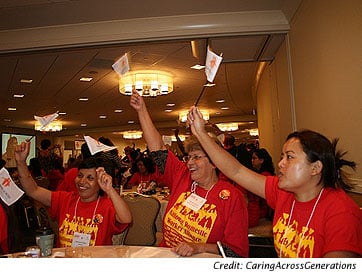
 NEW YORK (WOMENSENEWS)– The Department of Labor is in a public comment period until the end of February on a new rule extending wage protections to two groups of predominantly female workers; casual babysitters and companions for the elderly and infirmed.
NEW YORK (WOMENSENEWS)– The Department of Labor is in a public comment period until the end of February on a new rule extending wage protections to two groups of predominantly female workers; casual babysitters and companions for the elderly and infirmed.
These workers fell under a "companionship" exclusion when the Fair Labor Standards Act was extended in 1974 to other domestic workers, including housekeepers, cooks and chauffeurs.
Nearly 2 million home care workers–almost all women–make up a growing $70 billion industry in the United States. The job provides a unique mix of care and companionship, from babysitting, to administering medication, helping clients bathe, clothe and move around, and cleaning.
The home care industry more than tripled between 2001 and 2010, growing from 24,919 establishments or agencies to 82,239, according to the New York-based Paraprofessionals Health Care Institute. In 1963, that official figure was 1,100.
"Congress wasn’t thinking then about the work force as it is today," Robin Shaffert, a policy consultant for Caring Across Generations, a workers’ advocacy coalition based in New York and Washington, said in a phone interview. "And so what has happened is there is this broad group of people who are not doing this casually, who are supporting themselves and their families, and they are not covered by minimum wage and overtime provisions."
Caring Across Generation has five major goals, one for each finger of a worker’s caring hand.
Preparing good jobs for a projected 50 percent increase of personal care aides between 2008 to 2018 (from 921,700 to 1,328,600);
- Improving the quality of current jobs;
- Providing training;
- Providing a path to citizenship for undocumented home care workers;
- Supporting individuals and families.
Conditions Lag Demand
Caring Across Generations says home care workers’ access to job protections and training lags the boom in demand for their services.
Sylvia Liang, of Seattle, agrees.
Liang is employed by her 23-year-old son, living with autism. She said she has learned almost everything she knows about caring for him by simply raising him. She works out of their house and last year became involved with Caring Across Generations.
When she talks with other home care workers they recognize a common need for training, Liang said. "We know we don’t have as much training as we would like. I am not a medical professional. I learn from trial and error."
In 2009, the National Domestic Worker Alliance pushed through a groundbreaking domestic workers’ bill of rights that extended basic protections to nannies and housekeepers.
But the bill–which workers have successfully used to recoup wages–neglected home care workers, in keeping with the same definition of a domestic worker as outlined by the Fair Labor Standards Act, now subject to revision.
Jodeen Olguin-Tayler, field director of Caring Across Generations, said one person turns 55 every eight seconds in the United States.
"That totals more than 10,000 people a day," Olguin-Tayler, in a recent phone interview from her D.C. office. "It’s just a huge amount of people aging in the United States, and without a job creation plan for home care workers at the national level, we need to figure out how to fill this exploding need."
Tough Negotiations
The intimate and complicated nature of home care work can make it hard for a worker to negotiate and receive standard work conditions, said Olguin-Tayler, who also serves as campaign director for the New York-based National Domestic Worker Alliance.
"We hear things about people not having sick days, getting pressure to go to work when they are sick."
In July 2011 Caring Across Generations began a series of day-long "care congresses" across the country to fill in the education gaps.
The meetings are hosted and run by a grassroots network of advocacates for seniors, disability rights and in-home care workers. Funding comes from a mix of donations and money from Caring Across Generation, according to Olguin-Tayler.
Seven more of these meetings, which attract between 250 and 500 participants, are scheduled for later this year, including New York City, Seattle, Chicago and Miami.
Campaigners are looking for more state domestic workers’ bills of rights to follow and be expanded to home care health workers at the same time. One in California was introduced last year, and comparable bills are expected to arise in Washington state and Illinois in the coming year.
"A lot of the issues that I’ve seen workers bring up are very similar," said Perla Placencia, an organizer for the National Domestic Workers Alliance, based in New York, who helped organize a meeting for caregivers in the San Francisco Bay Are last summer. "Limited pay, lack of benefits, and just working in a stressful environment, because it’s so much responsibility to care for someone who has particular health needs. People really enjoy the work they do, but they aren’t being compensated for how important it is, and how hard it is."
Would you like to Comment but not sure how? Visit our help page at https://womensenews.org/help-making-comments-womens-enews-stories.
Would you like to Send Along a Link of This Story?
Amy Lieberman is a correspondent at the United Nations headquarters and a freelance writer in New York City.


